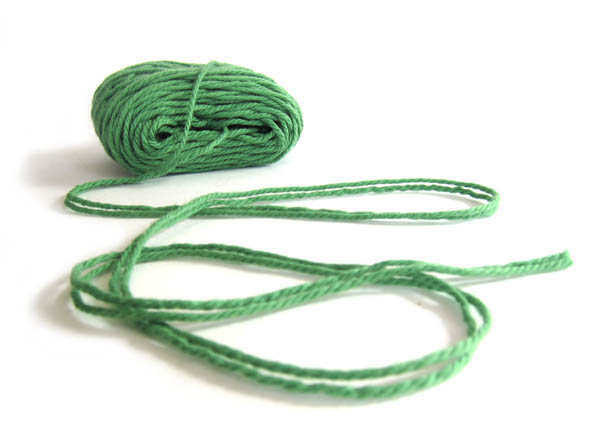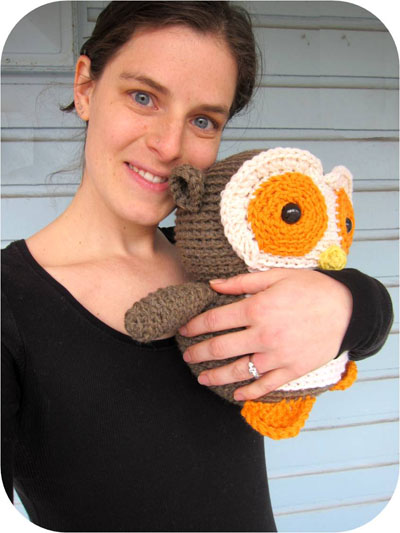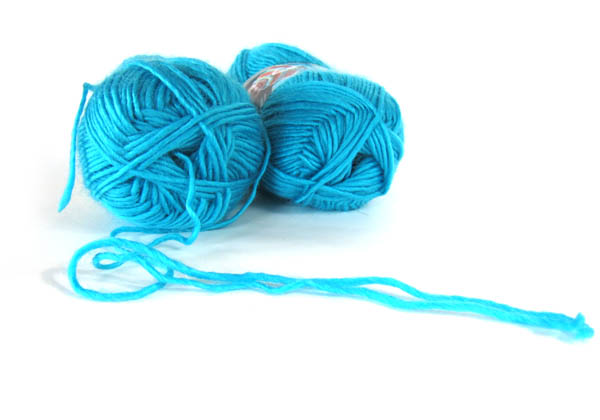I often get asked about the best way to work with two yarns at once. So, in this post, I’ll talk about the pros and cons of three different ways of working with a double yarn.
Of course, for any amigurumi pattern, you can crochet with two yarns at once, use a bigger hook and follow the pattern… and you’ll end up with a bigger animal! Fun! (shown above: a giant Nelson the Owl!)
Working with two balls of yarn
The most obvious way of working with two yarns at once is to simply hold two strands of yarn together from two separate balls of yarn.
advantages
- If you purchase your yarn already in balls, you don’t have to do much… just find the ends and go!
- If you want to do some interesting yarn combinations (such as hold one strand of plain yarn together with one strand of beaded yarn- which I’ve done when knitting a felted bag), no additional work needs to be done.
- Since the balls of yarn are independent, it’s okay if one ball is longer/shorter than another. Just work on a new second ball when one runs out.
- You can hand-wind your balls of yarn. Since you can work from the outside of the yarn, there’s no need to make center-pull balls (which either require a ball winder or a specialized hand-winding technique).
disadvantages
- Balls can sometimes be unruly. With this technique, some people struggle with keeping both balls of yarn in the same place, or keeping them from becoming hopelessly tangled. If you want to avoid this, consider winding two center-pull balls, and only working from the center. This eliminates (at least lessens the amount of) the ‘rolling-around factor’.
- If you purchase your yarns in skeins, you’ll need to wind two skeins at a time to work in this technique. This can sometimes be inconvenient.
- If you’re working on a small project that doesn’t need two balls worth of yarn, this technique requires modification. You can divide your yarn in half, and work with two smaller balls, but in my opinion, this eliminates the ‘easy advantage’ of this technique.
Work from two ends of a center-pull ball

A second technique is to work from both ends of a center-pull ball: holding the yarn that comes from the center together with the yarn that comes from the outside.
advantages
- You only need to wind one ball of yarn at a time: particularly great if your project requires only one ball of yarn, or an odd number of balls.
- You can do this ‘straight off the shelf’ with many yarns packaged as balls – most are center-pull.
disadvantages
- You’ll need to make center-pull balls… which either require a ball winder or a specialized hand-winding technique.
- This, like working with two balls at once, can sometimes become tangled and a little unruly.
Winding two balls of yarn together

A third technique is to wind two balls of yarn together, and then knit or crochet with the two ends.
advantages
- This technique is easy to work from: no ends or stray balls to get tangled.
- You can hand-wind your balls of yarn. Since you can work from the outside of the yarn, there’s no need to make center-pull balls (which either require a ball winder or a specialized hand-winding technique).
- If you purchase your yarn in skeins, winding two yarns together takes half the amount of time as winding two separate balls of yarn.
disadvantages
- If you purchase your yarn already in balls, this technique takes extra time to get started.
- If you’re working on a small project that doesn’t need two balls worth of yarn, this technique requires modification. You can divide your yarn in half, and then wind these two smaller balls together…but that makes this technique more time-intensive.
So, there you go! Hopefully, one of these techniques will be right for you!
Best,
Stacey







Hey, Stacey!
I’ve used methods 1 and 2 before, and have had far better luck with 1 than 2. With method 2, I end up with the whole thing twisting badly around its own ball very quickly. Since my yarn winder makes cakes rather than balls, method 1 works fairly well, especially once I put the cakes in my “custom-made, I’m only a little neurotic, really” containers that I use for my working yarn. 🙂
I’d never thought of / heard of method 3, and I’m eager to try it! (While I don’t regularly knit or crochet with two strands together, I’m thinking that this sort of thing would also be fabulous for two-at-a-time socks!)
I still need to get down to the store to pick up a copy of your book and get your John Hancock before you abandon us all here. 😉
meri
They each have their pluses and minuses… I think it depends on the type of yarn that you are using as well. Some yarns twist really badly, and others decide to behave 🙂
I’m moving May 31st, so come on down! I’m at A Tangled Skein Tuesdays 3-7.
See you soon!
Hello Stacey,
I am new to knitting. My mom has been knitting slippers my entire life. I’ve finally picked up on it after trying on and off for years. While I’m really enjoying it, I’m having problems with tangling. My issue is with two strands of yarn constantly twisting while I’m knitting. I have no problem with any tangling from the balls of yarn, it’s the actual strands I’m working with. My mom has watched me and I’ve tried to figure out what I’m doing wrong. I’m lost. I’d appreciate any feedback or advice. Please feel free to contact me via e-mail. Thank you.
Hi Tracy!
It’s true… when you’re knitting with two yarns at once, the yarns often get tangled.
I personally, don’t let it bother me. If they’re just twisting together, it won’t show up in the final knit product.
If it really bothers you, some folks put each skein in a ziplock bag (with the seal shut except for one piece of yarn coming out), and then, if you hold your knitting up, the skeins will more easily untwist. The downside to this is that you’ll have to pull harder on the yarns while knitting.
Unless you really don’t like the look of your finished product, I’d just keep on doing what you’re doing! Don’t let those tangles bug you!
stacey
nice run down! thanks for this… never heard of or thought of #3 before. will try with my next pair of two at a time socks. in the mean time i think i’ll stick to #1 as i agree with a commenter above that two ends of the same ball, with one end going around and round the other, can get messy.
Any thoughts on how much larger of a hook to use when using two strands? For example, if using a yarn for which you would usually use a 6mm hook, what size hook would people use for two strands of it together? Thanks!
That’s a little bit of trial and error. When I double a worsted weight yarn (that I use an H hook with), I use a size K hook… a little experimenting will let you know!
These are really great ideas for small projects. I would like to try to make an afghan using double strands. I live in Alaska and it gets very cold in the winter. Any and all suggestions are helpful and greatly appreciated. Patterns for two strands will be appreciated too. Thanks for all your help.
I use two separate balls or skeins each in a coffee (plastic) can of it’s own. Place them on the floor next to your left or right foot depending if you’re right or left handed. Leave the yarn in the cans to keep the yarn from rolling and to keep them clean. When you finish one row flip your piece over to untwist the working yarn. This keeps yarn from tangling. It takes a second to flip rather than what it takes to untangle an eternal mess. It does not have to be coffee cans. Any two containers to hold your yarn. I tape the containers together .If you rather use a tote instead of cans place two paper sacks side by side in your tote and put the yarn in, Don’t forget to FLIP your object.
I am making an afghan which uses two yarns together, the twisting is very time consuming and frustrating as you know.
I do not understand how to FLIP, please will you explain – thank you.
In this case ‘flip’ just means turn or rotate as a way of untangling the yarn.
Thank you! I was looking at a new pattern and it said ‘work with two strands of yarn’ and I was like WHAT?!
Being new to crochet I’d never heard of this, and now having read your instructions not only do I understand it, I can now choose how to go about it!
Thank you 🙂
So happy this post was helpful to you! 🙂
How can I change yarn if I have two yarn working like in making bags or thick items.
If you’re working with two yarns at once, I change yarns with the double up technique on just one yarn at a time! Works just the same 🙂
Hi everyone
I might be slow thinking. I am making a shawl with sleeves that required using two strands of bulky eight yarn. I have just went through the first two and it was tangling all the time. I was wondering when I start the next two aliens if I wind the two together before I start knitting will that lessen the tangling ?
Another question about using 2 stands of yarn at one time to crochet. When I get to the end of the first 2 skeins, how do I join ends of new skein & keep going?
You can use any method – tie a knot, do a Russian join, split splice (only works with wool yarn), etc. This post shows my favorite method. https://www.shinyhappyworld.com/2013/03/how-to-join-yarns-while-crocheting-with-no-knot.html